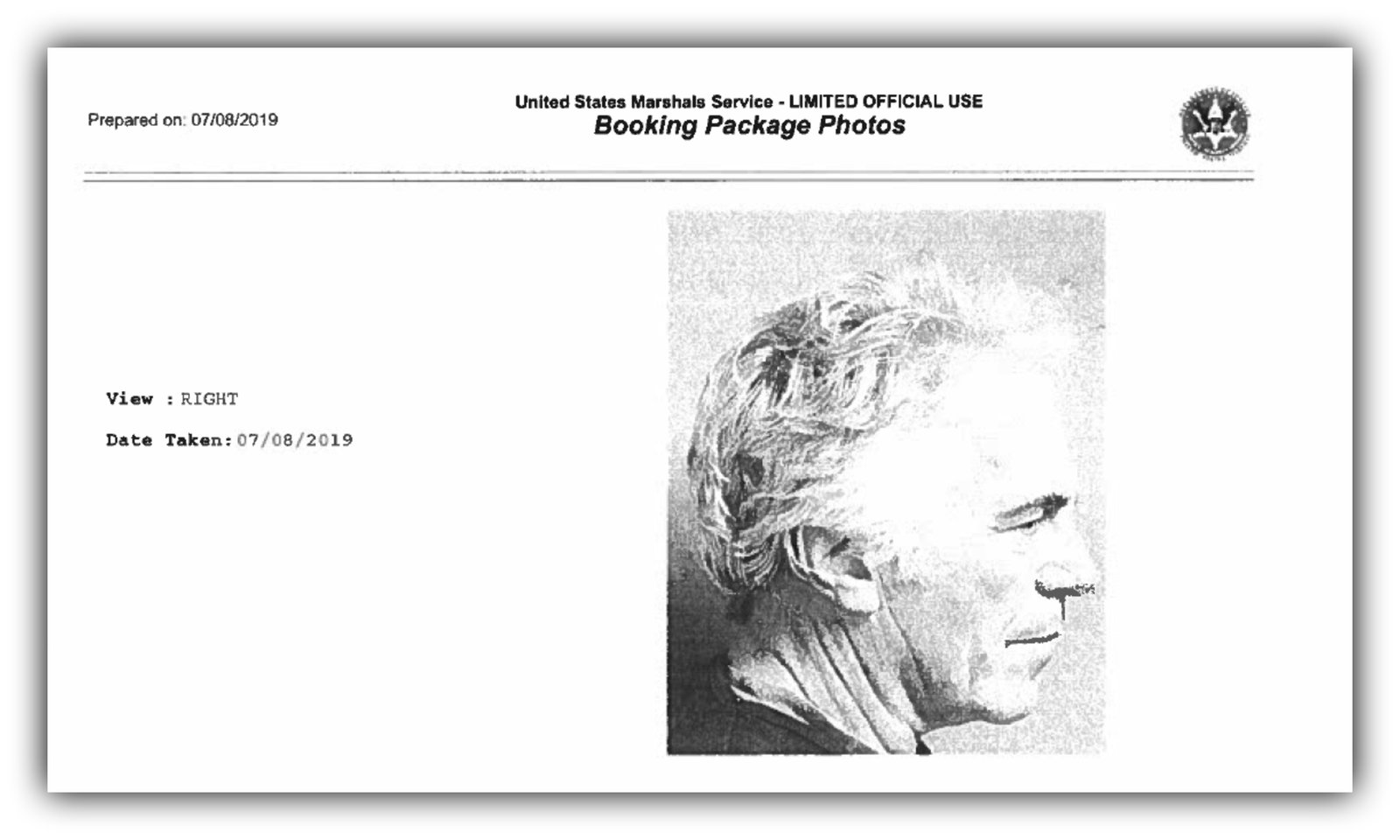Epstein July 8, 2019 Booking/Photo: U.S. Marshals Service
I. Executive Summary: Legislative Insurgency, Survivor Advocacy, and the Crisis of Transparency
The political landscape in Washington D.C. reached a critical inflection point in November 2025 regarding the federal investigation into Jeffrey Epstein, culminating in a successful legislative insurgency that forced a floor vote in the House of Representatives. This procedural victory, achieved through a rare bipartisan discharge petition, simultaneously intensified pressure on the executive branch and placed the issue of government transparency squarely before the Senate.
The central legislative vehicle for this movement is the Epstein Files Transparency Act (H.R. 4405), a bill introduced by Representatives Ro Khanna (D-CA) and Thomas Massie (R-KY). The bill demands the Department of Justice (DOJ) release all related files, investigative materials, and communications within 30 days of enactment. This effort achieved the necessary 218 signatures for a discharge petition on November 12, successfully bypassing the sustained resistance of House leadership.
The procedural success was amplified by a synchronized pressure campaign led by Epstein survivors and their legal teams, who held a news conference just hours before the anticipated House vote on Tuesday, November 18, 2025. The highly visible advocacy ensured the legislative debate remained focused on the imperative of justice and accountability, directly challenging attempts by the administration to dismiss the matter as a partisan distraction.
A profound political shift occurred on Sunday, November 16, when President Donald Trump abruptly reversed his long-standing opposition to the bill, urging House Republicans to vote for the release of the files. This pivot, widely viewed as political capitulation in the face of certain defeat, underscores the potency of a unified, cross-ideological push for transparency. H.R. 4405 is legally distinctive due to its stringent constraints on executive withholding, specifically prohibiting redactions based on “embarrassment” or “political sensitivity” to government officials.
The successful use of the discharge petition demonstrates that procedural mechanisms, rarely deployed successfully, can become powerful weapons of accountability when driven by overwhelming public interest and bipartisan moral consensus. The requirement that this arcane mechanism be employed at all highlights the depth of institutional resistance the administration mounted against transparency regarding powerful figures associated with Epstein. Furthermore, the synchronization of survivor testimony with legislative maneuvers ensures that the human cost and moral imperative of the files’ release are prioritized, maximizing the political consequence for any lawmaker attempting to obstruct the process.
II. The Capitol Hill Pressure Campaign: News Conferences and the Voice of the Survivors
The sustained demand for the release of the Epstein files did not originate solely in Congress; it was largely driven by the highly coordinated public advocacy of the survivors of Jeffrey Epstein’s abuse. These actions were crucial in shaping the public narrative and providing the necessary moral authority to transcend partisan divides within the House.
2.1. The Advocacy Timeline and Key Figures
The campaign for legislative action gained significant public traction in September 2025. During a major news conference held in Washington D.C., survivors specifically called upon lawmakers to support the nascent efforts by Representatives Massie and Khanna to force the release of all files.
A pivotal moment during this September event involved Marina Lacerda, who had previously been known for years only as “Minor Victim-1.” Lacerda, a key witness in the 2019 indictment against Epstein, decided to waive her anonymity to speak publicly outside the US Capitol for the first time. Lacerda, who was recruited for massages at Epstein’s New York townhouse when she was just 14 years old, used her platform to directly address the political opposition to transparency.
Lacerda specifically challenged President Trump’s characterization of the scandal as a “hoax.” She stated that Trump’s dismissal of the survivors had inadvertently “empowered” them and forced more people to listen, asserting that the administration’s attempts to hold back the files made the President “really look bad”. This direct engagement with executive political rhetoric set the tone for the campaign, framing the issue as a fight for truth against institutional obstruction.
2.2. Core Demands and Messages: Countering the “Hoax” Narrative
The subsequent news conference, scheduled for the morning of Tuesday, November 18, immediately preceding the House vote, was designed to exert maximum pressure on voting members. This event featured ten women, some of whom had never spoken publicly before, alongside legislative champions including Reps. Ro Khanna, Thomas Massie, and Marjorie Taylor Greene.
The message from the survivors focused intently on refuting the political minimization of Epstein’s crimes. One survivor unequivocally declared, “there is no hoax, the abuse was real”. Survivors Jess Michaels and Liz Stein urged the public to approach the issue not through a polarized political lens but as a “crime of human trafficking,” stressing the moral imperative of seeking transparency and “bringing all the men to justice”. Rep. Khanna underscored this sentiment, characterizing the upcoming vote as the “first day of real reckoning for the Epstein class”.
The news conference also served as a platform for survivors to express profound distress over decisions regarding accountability, notably their reaction to the transfer of Ghislaine Maxwell to a lower-security prison camp. Survivors reported being “horrified” by the transfer, emphasizing that Maxwell was found guilty of sex trafficking, participated in the abuse, and was a “major architect of the scheme”. Finding out about the transfer through the news, rather than official communication, further eroded trust in the justice system’s commitment to survivor advocacy.
The unified presence of key lawmakers, spanning the political spectrum from progressive Democrats to staunchly conservative Republicans, granted the movement significant moral leverage. This moral authority, rooted in the tragic narrative of human trafficking, successfully bridged the ideological divide required for the discharge petition’s victory. By focusing on the non-political tragedy of the abuse, the survivors and their legislative allies effectively neutralized the opposing argument that the bill was merely a partisan attack. The coordinated presence of numerous survivors—with a letter read on the House floor representing over 20 victims —also directly challenged the procedural obstructionists, who had claimed their resistance was based on protecting victims, exposing this rationale as likely a delay tactic.
III. The Mechanics of Legislative Overrule: The Discharge Petition Strategy
The scheduled House vote on the Epstein Files Transparency Act (H.R. 4405) is a direct consequence of a successful and exceedingly rare procedural maneuver: the discharge petition. This tactic was necessary to bypass months of sustained resistance from the majority party’s leadership, demonstrating the legislative body’s capacity for self-correction under extreme political pressure.
3.1. H.R. 4405: Legislative Intent and Scope
H.R. 4405, officially titled “To require the Attorney General to release all documents and records in possession of the Department of Justice relating to Jeffrey Epstein, and for other purposes,” was introduced in July 2025 by Democratic Representative Ro Khanna of California and Republican Representative Thomas Massie of Kentucky.
The bill’s central objective is to compel the Department of Justice (DOJ) to release a comprehensive set of materials within 30 days of enactment. This mandate includes making public all unclassified records, documents, communications, and investigative materials held by the DOJ, the FBI, and U.S. attorneys’ offices related to both Jeffrey Epstein and his associate Ghislaine Maxwell. Specifically, the bill targets flight logs, travel records, information about Epstein’s detention and death investigation, and records concerning the possible “destruction, deletion, alteration, misplacement, or concealment of documents” related to the case.
3.2. Procedural Conflict and the Discharge Petition
For months following its introduction, H.R. 4405 faced effective obstruction from House Republican leaders, including Speaker Mike Johnson (R-La.). Leadership argued that the House Oversight Committee’s own releases were sufficient, or claimed that the bill, in its original form, did not adequately protect victims.
To circumvent this institutional blockade, Khanna and Massie employed the discharge petition, an “arcane procedural tactic” designed to pull a bill out of committee and force floor action. This maneuver requires the signatures of a majority of the full House membership—218 representatives—a threshold that is notoriously difficult to reach, as it demands members to publicly defy their own party leadership.
The petition stalled at 217 signatures for several weeks. The procedural deadlock was broken on November 12, 2025, when newly elected Representative Adelita Grijalva (D-AZ) was sworn into office. Minutes after her swearing-in, Rep. Grijalva signed the petition, pushing the count to the necessary 218. The coalition that achieved this victory was comprised of all House Democrats and four specific Republicans: Representatives Massie, Marjorie Taylor Greene (GA), Lauren Boebert (CO), and Nancy Mace (SC).
The fact that House leadership forced the bipartisan coalition to rely on the discharge petition—a move generally reserved for highly contentious, log-jammed legislation—magnified the political narrative that the administration and its allies were actively shielding sensitive information. The resultant procedural victory was perceived not as voluntary transparency, but as a mandatory concession forced upon an unwilling establishment.
3.3. The Capitulation and Executive Reversal
The achievement of 218 signatures forced the hand of Speaker Johnson, who announced he would expedite the consideration of the bill and bring it to the floor for a vote the week of November 17. This procedural surrender set the stage for a dramatic political reversal by the executive branch.
President Trump, who had previously maintained that the controversy was a “Democrat hoax” meant to distract from other political successes , suddenly endorsed the bill late on Sunday, November 16. In his statement, the President claimed that Republicans should vote for the release because “we have nothing to hide”. This pivot followed intense White House efforts to persuade the dissenting Republicans, particularly Representatives Boebert and Mace, to withdraw their support from the petition. Facing the prospect of a potentially overwhelming bipartisan vote against his previous position—a “Maga Mutiny” with perhaps 50 or more defections—the President’s reversal was widely characterized as pragmatic damage control. By endorsing the release, the administration attempted to regain narrative control and frame the eventual passage of the bill as a Republican-led act of transparency rather than a forced political defeat.
IV. The Legal Mandate of H.R. 4405: Disclosure Requirements and Redaction Constraints
The Epstein Files Transparency Act (H.R. 4405) is unique not just for the high-profile subject matter it addresses, but for the stringent and highly specific constraints it places on the Department of Justice’s ability to utilize standard exemptions for withholding information.
4.1. Constraints on Executive Discretion
The most consequential legal component of H.R. 4405 is Section (b), which addresses Prohibited Grounds for Withholding. This section explicitly strips the DOJ of the ability to redact or withhold records based on non-essential, reputation-based criteria.
The law mandates that the Department of Justice “would not be allowed to redact information due to ’embarrassment, reputational harm, or political sensitivity, including to any government official, public figure, or foreign dignitary'”. This provision is a deliberate legislative effort to override established executive branch norms, where agencies typically retain broad discretion under various statutes to shield information that might cause political embarrassment or damage a public figure’s reputation. By preempting these standard exemptions, Congress has attempted to ensure that the final release is not subjected to political filtering by the current administration. This legislative move sets a powerful precedent for future high-stakes demands for federal transparency, particularly when the interests of powerful current or former officials are implicated.
4.2. Permitted Exemptions and Accountability Mechanisms
While the bill dramatically narrows the grounds for withholding information, it does recognize two standard, legitimate categories for redaction :
- Victim Privacy: The Department is permitted to withhold the personal identifying information of victims. This ensures that the victims, whose advocacy drove the legislation, are not re-victimized by public disclosure of private details.
- Active Investigation: Information that would genuinely jeopardize an ongoing active federal investigation may also be withheld.
To prevent the DOJ from abusing the “active investigation” loophole or other permitted redactions, H.R. 4405 includes robust oversight mechanisms. Within 15 days of completing the required publication, the Attorney General must submit a detailed report to the House and Senate Committees on the Judiciary :
- This report must list all categories of records released and withheld.
- It must summarize all redactions made, detailing the legal basis for each redaction.
- Critically, the report must include a list of all “government officials and politically exposed persons named or referenced in the released materials,” with no redactions permitted in this specific list.
This requirement for detailed justification of all redactions serves as a potent legislative check on executive power. If the DOJ attempts to heavily redact files under the guise of an “ongoing investigation,” they must promptly present a detailed legal justification to Congress, which retains the authority to scrutinize, challenge, and potentially expose any perceived abuse of the exemption.
Table Title: H.R. 4405 (Epstein Files Transparency Act) Provisions
| Mandate Area | Requirement | Legal Constraint or Exception | Citation |
| Disclosure Timeline | Release all unclassified records within 30 days of enactment. | N/A | |
| Scope of Records | DOJ, FBI, U.S. Attorney materials; flight logs, travel records, death investigation records, concealment records. | N/A | |
| Prohibited Redactions | Cannot withhold information based on “embarrassment, reputational harm, or political sensitivity” to public figures. | N/A | |
| Permitted Redactions | Victim personal identifying information. | Materials that would jeopardize an active federal investigation. | |
| Congressional Report | AG must list all politically exposed persons (PEPs) named and summarize all redactions (with legal basis) within 15 days post-release. | N/A |
V. Political Analysis: The Executive Branch’s Strategic Pivot
The vote on H.R. 4405 emerged from an acute political crisis for the administration, spurred by highly damaging document releases and an organized legislative uprising. The subsequent reversal by President Trump was a calculated strategic maneuver intended to preempt a major political defeat.
5.1. The Catalyst: Document Releases and Public Scrutiny
The pressure on the administration intensified dramatically in early November 2025 following the release of thousands of documents from the estate of Jeffrey Epstein by the House Oversight Committee. This trove of records, obtained via congressional subpoena, included emails that suggested President Trump “knew about the girls” and “spent hours” with one victim.
The White House reacted immediately and aggressively. White House Press Secretary Karoline Leavitt dismissed the release as a “manufactured hoax by the Democratic party” designed to smear the Republican President. Democrats, conversely, accused the White House of covering up potential involvement and continued to press for the Attorney General to release the full DOJ files. The release of the private estate emails, which provided specific and politically charged details, proved instrumental in pushing the discharge petition over the 218-signature threshold. The public spectacle continued as activists projected messages demanding the release of the files, along with images of Trump and Epstein, onto the Justice Department building on Monday night, November 17.
This interplay between shocking private correspondence (released by Congress) and institutional government records (held by the DOJ) demonstrates a critical mechanism for achieving transparency: the politically damaging details from non-government sources generate the political will required to compel the release of the official, state records.
5.2. The Sudden Reversal: Damage Control and Narrative Preemption
After months of opposing the release and attempting procedural delays, President Trump executed a startling about-face on Sunday, November 16, urging congressional Republicans to support the bill.
This reversal was necessitated by the inescapable procedural reality of the successful discharge petition. Analysts widely conclude that the pivot was a preemptive strategic move to avoid political humiliation. Facing the certainty of a successful vote—supported by every Democrat and four highly visible, defiant Republicans, particularly those from the conservative wing of the party like Marjorie Taylor Greene and Thomas Massie—Trump recognized that continued opposition would only reinforce the narrative that he was actively attempting to conceal damning information. The administration understood that the internal Republican fracture, or “Maga Mutiny,” on this issue presented a fatal political vulnerability within the President’s own base.
By reversing his opposition, the President strategically preempted the narrative of being defeated by Congress. He was able to reframe the vote as a voluntary act of transparency and compliance, declaring the files release a vote that the GOP had nothing to fear from. This action showcases that when faced with an irreversible procedural loss, the executive branch prioritizes narrative safety over sustained opposition.
VI. Future Obstacles: Senate Resistance and the “Active Investigation” Loophole
Despite the expected overwhelming passage in the House, the Epstein Files Transparency Act faces significant political and legal hurdles that could delay or even subvert the full mandated release of documents. The subsequent stages of the process, particularly in the Senate and within the Department of Justice, are anticipated to be where the deepest institutional resistance manifests.
6.1. The Senate Bottleneck
Upon passing the House, H.R. 4405 must clear the Senate, where Republicans hold a 53-47 majority. Senate Majority Leader John Thune (R-S.D.) has remained noncommittal regarding bringing the bill up for a vote. Thune previously stated in September that he could not comment on whether the Senate would take up the measure, adding that he trusted the Justice Department to release information “in a way that protects the rights of the victims”.
This reluctance suggests that the bill faces a significant risk of procedural death by inaction. Unlike the House, where the discharge petition forced a vote, the Senate lacks an equivalent mechanism for bypassing leadership obstruction. Thune’s position, prioritizing trust in the DOJ’s internal processes, indicates a potential willingness to delay or entirely block a floor vote, effectively killing the legislation and requiring a renewed, potentially massive public campaign to force action.
Adding to the legislative complexity, House Speaker Johnson suggested that the bill did not sufficiently protect victims and expressed “some comfort” that the Senate would amend the bill to “correct some of those concerns”. This proposal risks a procedural ping-pong: any amendment made in the Senate would require the bill to return to the House for re-approval, consuming valuable time and potentially delaying the final outcome. Rep. Thomas Massie delivered a sharp warning to the Senate, urging them not to “muck it up” with amendments unless they were a genuine effort to strengthen the bill, noting that any obstruction would “backfire on the senators”.
6.2. The Weaponization of the Investigative Exemption
The most acute legal and political threat to the full disclosure mandated by H.R. 4405 lies within the statutory exemption permitting the DOJ to withhold records related to an “active federal investigation”.
Legal analysts and even key bill sponsors have raised concerns that the administration may use this exemption as a calculated loophole for continued obstruction, even after publicly endorsing the bill. The President recently ordered a new probe into several political opponents concerning their alleged links to Epstein. Rep. Massie suggested this move might be a “smokescreen” and a “last-ditch effort” to prevent the file release.
As former federal prosecutor Barbara McQuade observed, this maneuver is likely a “strategic effort to block the release of further documents”. By initiating a new investigation, the DOJ gains the legal standing to assert executive privilege and invoke the law enforcement exemption over any document deemed relevant to the new probe. This allows the executive branch to demonstrate public compliance by supporting the bill while simultaneously achieving legal operational defiance, effectively maintaining control over the most sensitive records. The dual strategy—public relations compliance via the vote, and legal blockage via the new investigation—represents a sophisticated maneuver to subvert congressional intent.
VII. Policy and Accountability Implications
The successful movement to compel a vote on the Epstein Files Transparency Act stands as a landmark case study in legislative accountability and the political dynamics of transparency demands in the modern era.
The saga of H.R. 4405 validates the power of procedural tools, specifically the discharge petition, when marshaled by a determined, bipartisan coalition facing institutional obstruction. The fact that congressional members crossed party lines—including Republicans aligned with the executive branch—to force the vote highlights a critical check on executive overreach and demonstrates that certain moral and public interest issues can override fierce partisan loyalty. The necessity of this procedural fight confirms that significant institutional inertia exists to protect powerful individuals, regardless of political affiliation.
Furthermore, the legal text of H.R. 4405 establishes a significant policy precedent by specifically eliminating “political sensitivity” and “reputational harm” as permissible grounds for executive redaction. This provision represents a powerful, legislative counter-response to the perceived political weaponization of executive privilege and secrecy exemptions.
However, the legal fight is poised to continue. While the House vote is likely to pass overwhelmingly, the bill’s journey through the Senate and the potential legal challenges posed by the DOJ’s “active investigation” exemption will determine whether true transparency is achieved. The ongoing calls from survivors to reveal the enabling network surrounding Epstein (“bringing all the men to justice”) underscore a profound, lingering public distrust in the federal government’s willingness to fully expose high-level malfeasance. The legislative mandate of H.R. 4405 is thus not merely about files, but about utilizing congressional power to force accountability for the individuals of the “Epstein class.”




